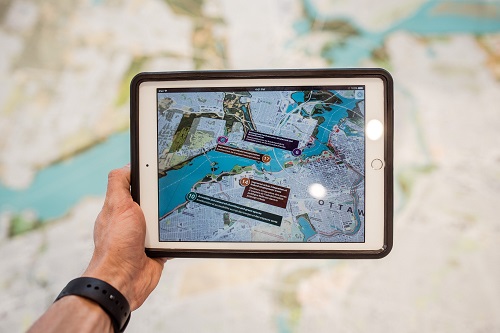Activism and Other Uses for Augmented Reality
AR is an emerging technology that is slowly but surely infiltrating our lives in many subtle ways. When you think about AR, the first examples to pop up are games like Pokemon Go or Snapchat filters. For me, one of the ways AR has manifested itself in my life without me noticing it was through K-Pop photocards. When scanning these small pictures of my favorite artists through an app, different videos would suddenly appear, floating above the picture. It was new and exciting to me as I had never seen something similar before. At the time, I didn't know the technology used behind these interactive photocards was called "Augmented Reality". I only just learned about it through AR Cité's workshop that took place at Dawson on February 24th.
 This Dawson student-centered project uses AR to bring our neighbourhood alive by making it tell stories we don't know about. Each time we scan a specific picture with the app AR Cité, a story is revealed. Through this workshop presented by the project lead, Reisa Levine, we learned about the history as well as creative possibilities of AR and even got to test the app. It is available on the app store for both iOS and Android.
This Dawson student-centered project uses AR to bring our neighbourhood alive by making it tell stories we don't know about. Each time we scan a specific picture with the app AR Cité, a story is revealed. Through this workshop presented by the project lead, Reisa Levine, we learned about the history as well as creative possibilities of AR and even got to test the app. It is available on the app store for both iOS and Android.
This initiative clearly connects scientific, artistic and social concepts; its aim is to bring awareness to untold stories in our society through appealingly designed and organized visual media, all of it supported by AR technology. For example, in Joe Rose's AR Cité story, the founder of the Etcetera club would appear on our screens covered in beautiful pink flowers. An homage paired with a creative reference to his bright pink hair we couldn’t see because the picture is in black and white.
What most interested me in the event was to learn about AR activism. I hadn't thought of the possibility of using this technology as a way to raise awareness on important societal and environmental matters. For example, AR has been used to replace ctontroversial statues in big cities, which is particularly relevant to Montreal as concerns around some of our own statues have arisen in the past years. Also, this technology has been used to populate urban spaces with plants to promote sustainability.
Unfortunately, the lack of a universal AR platform is very limiting to creators as it makes it less accessible to them and audiences. Indeed, most of time big companies buy emerging AR apps and platforms which leads them to fall out of your average person’s grasp.
It made me wonder how powerful AR could become if only a common highly accessible app existed. Would it become a new type of social media? I believe it would definitely have the potential.
To find out more information about the organization, you can check out their website: arcite.ca.

Comments
No comments posted yet.
You have to be registered and logged in in order to post comments!